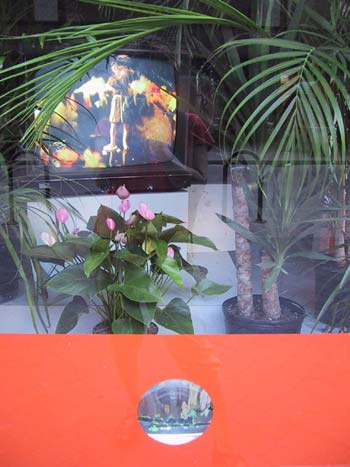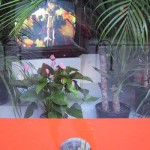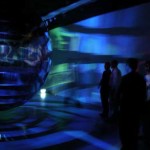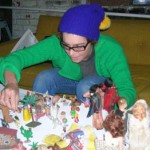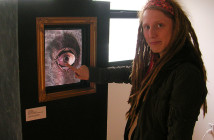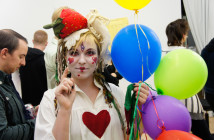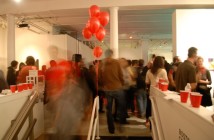I first met Liz Nofziger during her graduate thesis show at the Massachusetts College of Art in the spring of 2004. I was immediately drawn to her work because of the ways that she brings so much attention to the tiniest of details. In that show one could to climb a 12-foot ladder in a gallery to inspect miniature figurines perched on an overhang. In another part of the gallery, if you looked inside a bucket on the floor in what seemed to be a pile of trash, you would see a rather gruesome image of a chicken head after it had been cut off from its body, its beak still attempting to squawk in vain as its life fades away. Liz is also constantly pushing herself to explore ways to present and work with the ever-evolving medium of video installation. Nofziger challenges viewers by placing them in often-awkward situations, where one questions if they are looking at the art or is the art watching them. Over the last year since we met, I have had several opportunities to work with Liz. I have included her in two exhibits that I curated and I have also had the chance to show my own artwork alongside her in two other shows as well.
Liz Nofziger has been quite busy lately; in just the past few months she has had numerous shows. In August, Liz was part of a group show "Mass Media" at Axiom Inc, where she had a presented a follow up of sorts to her earlier chicken head piece, a video showing a chick just hatched that is being torn apart by an army of ants. Later in August she had a solo exhibit, "Spin", at the Montserrat College of Art as well as a multimedia window installation as part of the most recent Boston Windows Project "$ome ©olor", at Downtown Crossing in Boston.
Currently, Liz is showing in "Some Sort of Uncertainty" at the Doran Gallery at Mass Art. She is also part of ES PRESENTS! an exhibit featuring artists involved with Environmental Services at a loft in Chelsea, MA.
Recently, Liz and I somehow managed to co-ordinate a free time slot that fit both of our busy schedules and we got a chance to catch up over a cup of tea, at her studio in the Atlantic Works studio building in East Boston.
(This article is enhanced with audio recordings. Click the ![]() icon to open audio in a new window.)
icon to open audio in a new window.)
JM: Liz, besides being in numerous shows, you have been traveling quite a bit recently, where have you been?
LN: In late September, I went to Barcelona, and then I went to Venice and got to see the Biennale. I had never been to Spain or Italy before so that was exciting. It's hard to say specifically what influence it has had on my work as an artist, I saw so much I am still digesting it all. My being interested in working from actual sites was really sparked by seeing places like Venice and the many parts of the Biennale that were scattered around the city.![]()
JM: You also just completed a solo project at the Montserrat College of Art. How did the project "Spin" evolve, and what were some of your ideas on the process of making it and the concepts behind it?
LN: I was invited to do "Spin" at the 301 Gallery at Montserrat and it was a great engineering challenge for me I had to learn a lot of new skills to make this piece happen. It was pretty nerve racking, because of the size and complexity of the piece and not being able to fully assemble and test the piece before it was installed. I collaborated Erica Moody, who is architectural metal smith and fabricator with a shop in Jamaica Plain. She helped with some of the more complicated parts that were made with steel and aluminum plate. The gallery itself is a great space with 12-foot high tin ceilings and storefront windows that let in lots of light that you can control. Across the street from the gallery space was an old laundry with a glass facade and you can see all of the spinning washers and dryers and bright plastic chairs and I began to play off of the idea of the machines spinning. I wanted to play off of the ideas of spinning in a more complex and cultural ways, and I was interested in starting with the laundry and how you cannot escape the barrage of media. For example, its ridiculous at the Shaw's market down the street from me, they just filled the entire store with flat screen monitors advertising vegetables when the actual vegetables are right there in front of you! I am thinking what a waste of a perfectly good flat screen that could be used for in a much more interesting artistic ways.![]()
So as the idea evolved I began to play with a disco ball in my studio with projections, which by the way, was fabulous, everything you imagine it is! The idea was expanded to ominous scale, which filled an entire room everything scaled up so there were big chunks of images all around the room. When finished there was a live feed broadcast television projected on it from two sides reflecting off of the 1-foot square mirrors covering the rotating 11-foot high disco ball. The ball was rotating at a speed that was just fast enough to be disorientating but not fast enough so you would throw up.![]()
JM: What kind of dialogue did you have with the students at Montserrat while working on "Spin", being that you recently graduated from Mass Art yourself? Did you have advice for them?
LN: I was very interested in showing next to the studios where students work so that I could have a dialogue with them as the piece came together. I was installing just before school started so I missed out on the opportunity to have them help out or be a part on the actual install. I gave several talks to students. They asked a lot of good questions like "How do you keep yourself motivated when you are out of school?" and "How do you find or make opportunities happen in the real world?" Besides just giving them a list of resources and websites I really tried to encourage them to be proactive and to get involved in the community and show them that if you get involved you can make things happen.
JM: You always come up with interesting ways to present your videos in a way that is more than just an image projected on a wall or on a monitor, what are some ways you have worked with this idea?
LN: I am interested in presenting video in a more sculptural way, if I am projecting I generally don't do a straight up single channel projection but I prefer to have the image transformed, such as in "Spin" where the image of trash television transformed into to something completely different that is wafting over you and moving around you. It becomes a magical thing even though you realize it all along for what it is, that's it's selling you Viagra or it's Divorce Court or the news or whatever is on. In this case the point was to comment on the inescapable media.
In other pieces, such as my "Bubble Gum" video, I presented it on an old thrift shop television with rabbit ears, as it fits in better with the work, which is a more stylized period type of piece. Other times I build a specific environment for that piece such as with "Garbage" (the chicken head piece) where I took a bucket and cut out the bottom, I then attached a laptop screen to the bottom of the bucket and used cardboard boxes to hide the gear and dress it up. I like the idea of how it appears as metal bucket in a pile of trash and you really are surprised if you are curious enough to look inside the bucket.
In another example, such as my recent ant piece, that is shown a raw LCD panel with its covers removed so that all its inner parts are exposed much like how the chick in the video is being covered and pulled at by the ants is exposed.
I am fascinated by being able to shift scales and perspectives, often times going from macro to micro in the same piece, like I did in Oasis, the Boston Windows Project piece was fun because I was able to incorporate many different details of miniature figures that were hidden about a living collection plants and crystals. There were all in an environment that constantly evolved as time went on. Being a storefront window in Downtown Boston, It was exciting that many people, from many backgrounds were able to participate.![]()
Generally I am more interested in a space that is not just a plain white wall, For instance I am part of a show that Douglas Weathersby organized at a loft in Chelsea, MA, where he invited people associated with Environmental Services to create pieces. It is my kind of show to be a part of because it was an interesting space away from a white box, I was able to explore the space and I found a trap door above the loft where I was able to hide a projection.
Its hard to guide a viewer without giving away too much. Part of it is exploring on your own but I enjoy the idea that one has to really take time and explore things on their own.
JM: You have an active role in the Atlantic Works studios and gallery. You are a board member here and earlier this year you did a collaborative exhibit, "Pe(s)t", with another Atlantic Works artist, Peter Pizzi. What are your thoughts of that collaboration and being a part of the East Boston arts community?
LN: When Peter and I began working on "Pe(s)t" we had only just met, we are both members of the Atlantic Works building and met during open studios. He and I both look at the world in similar ways but with enough difference where we could work together comfortably. He does much more complex filmmaking where I tend to be much more direct. Peter is a crazy pet lover and I am defiantly not interested in pets. We both enjoyed the idea of inviting people to play inside an entire environment of a human scale pet cage, where humans could interact with each other much as gerbils interact with each other. All along being watched over by the inhabitants of 1/4" scale model doll house just beyond the bars of the cage. We were also interested in the concept of where is an animal a pet or a pest? We concluded it is basically the habitat they have, and how they interact.![]()
I love being a part of this community in East Boston and the Atlantic Works gallery and studios. There is a diverse group of artists here and we run the place ourselves, so it takes a lot of effort to keep motivated but it is very rewarding. Because artists are so much a part of things here everyone is pretty understanding of the artists process so if one of us needs a break we can take a step back and others will fill in. East Boston seems to be a stable environment for artists compared to other areas of the city where there is out of control rents and high turnover of spaces. This building was just bought by the East Boston Community Development Corporation, which is planning to keep this as cultural space and hopefully everything will be okay for a while.
Links:
Nofzilla (Nofziger's website)
Montserrat College Art Gallery
Magma Metalworks
Axiom, Inc.
Atlantic Works Gallery
"Some Sort of Uncertainty" is on view November 7–9, 2005 at the Doran Gallery at Mass Art.
All images of artwork are courtesy of the artist.
Photos of Liz Nofziger by James Manning.

